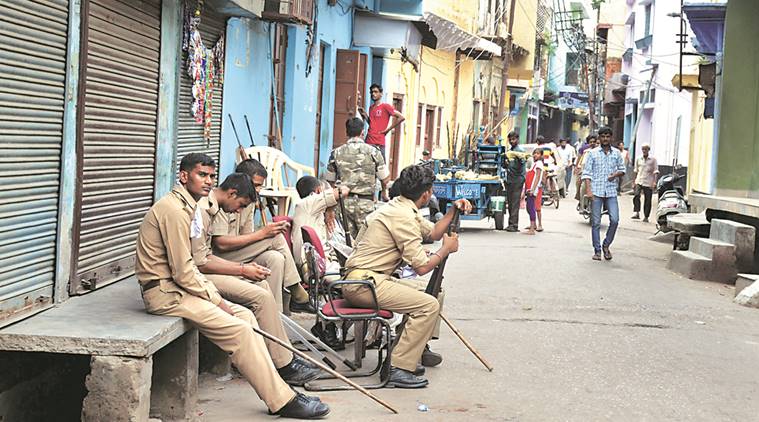Only a couple of months ago, disturbing news reports had started coming in from Western UP. These reports pointed towards a massive exodus of Hindu families from areas such as Kairana and Kandhla. It was alleged that the exodus was on account of goondaism of some Muslim gangsters of these areas. Even before the facts could be established, Mainstream media tried to sweep the issue under the carpet. It was claimed that not only Hindus, but some Muslim families had emigrated as well. The authenticity of lists of emigres produced by BJP MP, Hukum Singh was questioned. Insinuations were made that BJP was deliberately trying to stoke communal passions. After a few days of coverage, Kairana and Kandhla were forgotten. It now appears that Kairana and Kandhla were not isolated incidents. It seems that nefarious forces are at work, terrorizing innocent citizens to flee in order to execute a demographic change. Western UP has historically had a significant Muslim population alongside a strong Hindu majority. Over the years, however, multiple factors have resulted in a situation where an increasing Muslim population has begun to edge out the Hindu population. For example, Muzaffarnagar, the site of 2013 riots used to be 71% Hindu in 1981. As per 2011 census, that number stands at 56%. Similarly for Kairana, 2011 census counts around 68% of the population as Muslim, whereas that number in 2001 was 48%. As per estimates, the number of Hindus in Kairana had dwindled to 8% in June 2016. And that is not it, recent newspaper reports point towards a similar trend in Aligarh. After a married woman was molested by Muslim youth, Hindu families in Aligarh have sought the district administration’s help in selling off their property and settling elsewhere.
Like many towns in Western Uttar Pradesh, Aligarh too has a substantial Muslim population, living beside a small Hindu majority.
2011 census puts the Aligarh numbers as 55% Hindus against 43% Muslims, that number was closer to 60% for Hindus in 1971.
Aligarh also has a chequered past when it comes to communal harmony. There have been 7 major communal riots in the town since 1947. The most recent one in 2015 when crackers were burst near a house where bereavement had recently happened. In 2006, riots happened over Ramnavami celebrations when some Muslims objected to the decorations being put up or alternately objected to the night long celebrations. Heavy paramilitary presence finally succeeded in enforcing calm in the town. Incidentally, Aligarh also has a dark underbelly, where gangsters, Hindu and Muslim alike vie for supremacy. The role of Aligarh Muslim University is also frequently brought up as a malignant force. Incidentally Aligarh Muslim University played a significant role in establishing the identity of Muslims as non-Indians in the years preceding the partition of India. There is reason to suspect that evil forces in Aligarh are trying to make environment unlivable for non-Muslims so as to force them out of the area.
The question that arises is why are Hindus the first to flee when the environment becomes hostile? Not so long ago, Kashmir was emptied of its Hindu population. Even now, reports surface indicating that Hindus are similarly being made to flee from parts of West Bengal. Why do Hindus find it easier to flee than to stay put and fight? There are three main reasons for this-
- Caste structure
In spite of the general enfeeblement of the caste system, Hindus fail to band together as one consolidated bloc when the going gets tough. Years of secular politicking have created political alliances of convenience, e.g. Muslims and Yadav, Jats and Yadav, Muslims and Dalits etc. that have further blurred grounds of a common religious identity among Hindus. No wonder that Hindus fail to respond unitedly to a crisis and more often than not end up being the victims.
- Economics
Hindus in general have tended to be more prosperous and well off than their Muslim neighbors. In the face of a conflict, it is far easier for Hindu families to flee than to fight because they can afford an equally good lifestyle at another location. For many poorer Muslim communities, flight is never an option and hence they need to be more aggressive. The poorer Hindus, for whom there is no place other than home, similarly choose to fight rather than flee when a communal crisis erupts.
- Politics
Secular politics of the country has resulted in a situation where a Muslim fighting for his rights is seen as a worthy secular warrior, while a Hindu doing so is labelled as a bigot. The reaction of our secular polity to the crisis in Kashmir, Kairana or Kandhla clearly shows that the plight of Hindus in the country. Since Hindus are not a cohesive vote bank, it makes no sense for politicians to stand up against injustices meted out to them.
Until Hindu society learns to stand up for itself, erases divisions amongst itself and becomes more assertive, many more Kashmirs, Kairanas and Aligarhs will continue to happen. Hindus will continue to be hounded out, terrorized and forced to flee or simply edged out. The need is not for communal riots or violence against others but for a common, proud and united sense of identity.
